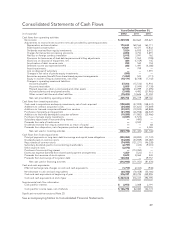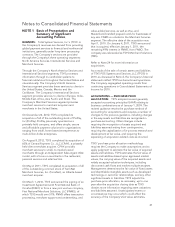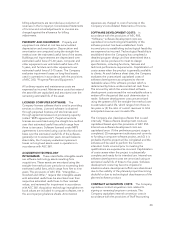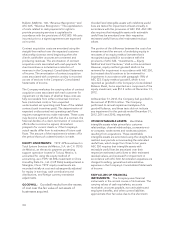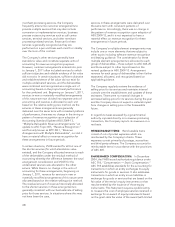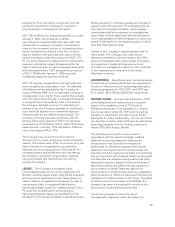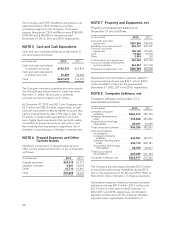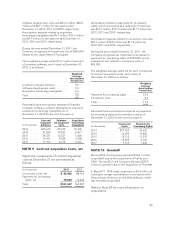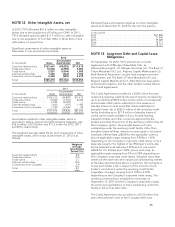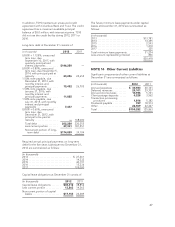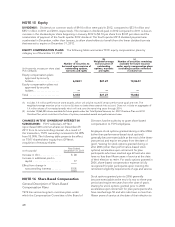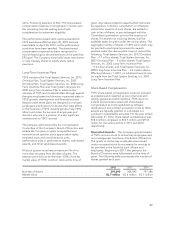NetSpend 2012 Annual Report Download - page 42
Download and view the complete annual report
Please find page 42 of the 2012 NetSpend annual report below. You can navigate through the pages in the report by either clicking on the pages listed below, or by using the keyword search tool below to find specific information within the annual report.exceptions). That cost will be recognized over the
period during which an employee is required to
provide service in exchange for the award.
ASC 718 is effective for all awards granted on or after
January 1, 2006, and to awards modified,
repurchased or cancelled after that date. ASC 718
requires the Company to recognize compensation
costs for the nonvested portion of outstanding share-
based compensation granted in the form of stock
options based on the grant-date fair value of those
awards calculated under the provisions of ASC 718,
for pro forma disclosures. Share-based compensation
expenses include the impact of expensing the fair
value of stock options, as well as expenses associated
with nonvested shares. TSYS adopted the provisions
of ASC 718 effective January 1, 2006 using the
modified-prospective-transition method.
ASC 718 requires companies to estimate forfeitures
when recognizing compensation cost. The estimate
of forfeitures will be adjusted by the Company as
actual forfeitures differ from its estimates, resulting in
compensation cost only for those awards that actually
vest. The effect of the change in estimated forfeitures
is recognized as compensation costs in the period
the change in estimate occurred. In estimating its
forfeiture rate, the Company stratified its data based
upon historical experience to determine separate
forfeiture rates for the different award grants. The
Company currently estimates a forfeiture rate for
existing stock option grants to TSYS non-executive
employees, and a forfeiture rate for other TSYS share-
based awards. Currently, TSYS estimates a forfeiture
rate in the range of 0% to 10%.
The Company has issued its common stock to
directors and to certain employees under nonvested
awards. The market value of the common stock at the
date of issuance is recognized as compensation
expense over the vesting period of the awards. For
nonvested award grants that have pro rata vesting,
the Company recognizes compensation expense
using the straight-line method over the vesting
period of the award.
LEASES: The Company is obligated under
noncancelable leases for computer equipment and
facilities. As these leases expire, they will be evaluated
and renewed or replaced by similar leases based on
need. A lease is an agreement conveying the right to
use property, plant, or equipment (land and/or
depreciable assets) usually for a stated period of time.
For purposes of applying the accounting and
reporting standards, leases are classified from the
standpoint of the lessee as capital or operating leases.
Rental payments on operating leases are charged to
expense over the lease term. If rental payments are
not made on a straight-line basis, rental expense
nevertheless shall be recognized on a straight-line
basis unless another systematic and rational basis is
more representative of the time pattern in which use
benefit is derived from the leased property, in which
case that basis shall be used.
Certain of the Company’s operating leases are for
office space. The Company will make various
alterations (leasehold improvements) to the office
space and capitalize these costs as part of property
and equipment. Leasehold improvements are
amortized on a straight-line basis over the useful life
of the improvement or the term of the lease,
whichever is shorter.
ADVERTISING: Advertising costs, consisting mainly
of advertising in trade publications, are expensed as
incurred or the first time the advertising takes place.
Advertising expense for 2012, 2011 and 2010 was
$1.0 million, $813,000 and $690,000, respectively.
INCOME TAXES: Income taxes reflected in TSYS’
consolidated financial statements are computed
based on the taxable income of TSYS and its
affiliated subsidiaries. A consolidated U.S. federal
income tax return is filed for TSYS and its majority
owned U.S. subsidiaries through the year ended
December 31, 2012. Additionally, income tax returns
are also filed in states where TSYS and its subsidiaries
have filing obligations and in foreign jurisdictions
where TSYS has a foreign affiliate.
The Company accounts for income taxes in
accordance with the asset and liability method.
Deferred income tax assets and liabilities are
recognized for the future tax consequences
attributable to differences between the financial
statement carrying amounts of existing assets and
liabilities and their respective tax basis and operating
loss and tax credit carry forwards. Deferred tax assets
and liabilities are measured using enacted tax rates
expected to apply to taxable income in the years in
which those temporary differences are expected to
be recovered or settled. Reserves against the
carrying value of a deferred tax asset are established
when necessary to reflect the decreased likelihood of
realization of a deferred asset in the future. The effect
on deferred income tax assets and liabilities of a
change in tax rates is recognized in income in the
period that includes the enactment date.
Income tax provisions require the use of
management judgments, which are subject to
39


